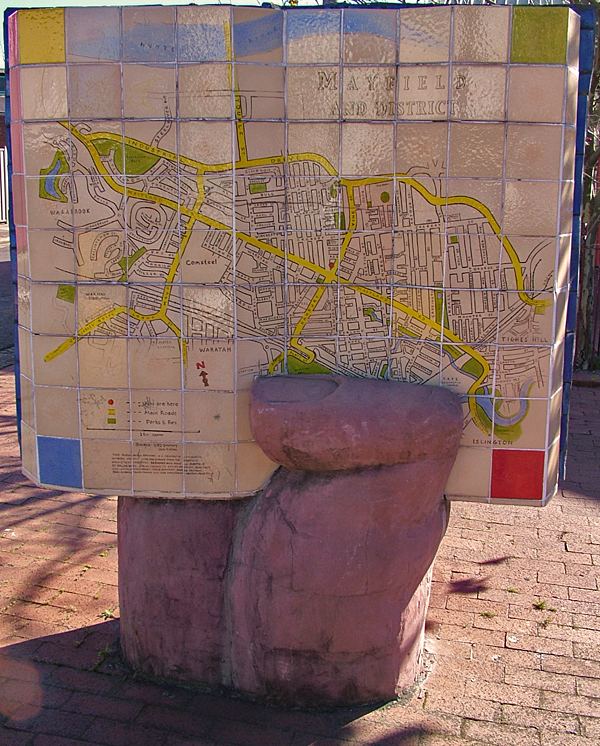Population 12,248 (2001 census) Postcode(s) 2304 Postal code 2304 Local time Thursday 12:42 PM | Established 1880s Area 8.1 km² | |
 | ||
Location 6 km (4 mi) NW of Newcastle Weather 26°C, Wind NE at 16 km/h, 81% Humidity | ||
Mayfield is a north-western suburb of Newcastle, New South Wales, which takes its name from Ada May (born 1874) a daughter of the landowner there, John Scholey, J.P. Its boundaries are the Hunter River to the north, the Great Northern Railway on the south (Waratah Station), the main railway lines to Newcastle harbour on the east, and open ground in the west.
Contents
Map of Mayfield NSW 2304, Australia
History
Much of Mayfield was originally named North Waratah, and formed part of the large Municipality of Waratah, New South Wales (incorporated 1871), of which John Scholey was three times Mayor. In 1938 an Act of the New South Wales Parliament created a "City of Greater Newcastle", incorporating 11 municipalities into one local government area, including Waratah. Until it was subdivided by Scholey and the land put up for sale, it was largely semi-forested scrub and fields. However, St Andrew's Church at North Waratah was opened as early as 1861, and fell within the Church of England Diocese of Newcastle, New South Wales. In 1924 a new church was dedicated at St.Andrews, Mayfield, to replace the aging colonial church.
Mayfield was originally a pleasant garden suburb on the outskirts of Newcastle, and by 1901 contained a Roman Catholic monastery, and several fine Victorian mansions belonging to prominent businessmen and lawyers. Of note, there was N.B.Creer (three times Mayor of Waratah), Charles Upfold (Soap Manufacturer) built a large mansion on a piece of land in Crebert Street, North Waratah (now called Mayfield), given to him by his friend John Scholey. It was later sold to the famous Biscuit manufacturer, William Arnott J.P. who named the mansion "Arnott Holme". Arnott then sold it in 1898 to Isaac Winn, owner of the big Newcastle department store. Winn renamed the mansion "Winn Court" and John Scholey's "Mayfield House", for which the sandstone was brought from England. The BHP constructed, in the early 1920s, a very fine mansion in Crebert Street (named after Peter Crebert [1825-1895], an immigrant from Wiesbaden in Germany), with extensive gardens, for their General Manager. Now privately owned and named The Bella Vista, it is used as a weddings and functions centre.
Arrival of industry
In 1896, the Broken Hill Proprietary Company Limited had acquired land on the river shore at Mayfield East for smelters, and in 1910 it was decided that they would construct here a major steel works and foundries, with a 350-ton blast furnace and three 65-ton open hearth steel furnaces, a bloom mill and heavy rail mill, with by-product coke ovens to supply coke for the blast furnaces. The advantages of the site played a major part in this decision: for transport both rail and shipping already existed, and they had close proximity to the Newcastle and South Maitland coalfields, (the coal consumption in 1947 was 30,000 tons each week). The task of reclaiming swampland at Port Waratah for the main site began in January 1913, and the New South Wales Government undertook to dredge and maintain a river channel between the works and the sea, 500 feet (150 m) wide and 25 feet (7.6 m) deep at low water to the steelwork's basin and wharves. Altogether the company acquired 1,225 acres (4.96 km2). The blast furnace commenced operations in March 1915.
Other industries followed, such as galvanized iron manufacturers John Lysaght & Co., (1921), Rylands Bros (wire, nails, rivets, bolts, springs etc.), tubemakers Stewarts & Lloyds (1934), and the Newcastle Chemical Co., (1940), and sited themselves adjacent to the steel works. The result was pollution which began to affect Mayfield which lost its fashionable status. The housing erected during and after World War I was overwhelmingly for those with employment in the heavy industries. The Steel Works finally closed down in the late 1990s and this had a knock on effect with adjacent industries, several of whom were now struggling with developing world markets.
Today
Today Mayfield is the most culturally diverse suburb in Newcastle and home to over 14 000 residents from all over the world.
